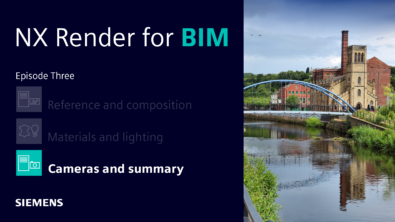The benefits of SaaS (Software as a Service)

SaaS, or software as a service, is a growing software delivery model. On this episode of the Next Generation Design podcast, our host Jennifer Piper talks to Paul Brown, Senior Marketing Director at Siemens Digital Industries Software about SaaS and its rising popularity among companies.
In this episode, you’ll learn about the benefits of SaaS to companies and users. You’ll also learn about the different products that Siemens offers as SaaS, including the most recent addition. Additionally, Paul will share his views on the future of SaaS and why it should not be seen as a replacement for desktop solutions.
Listen to or read the full episode: The Magic of Software as a Service (SaaS)
What you’ll learn in this episode:
Why companies are adopting SaaS
Software companies have been offering solutions as SaaS to make their technology more accessible for their customer companies and individuals. SaaS, because it is available on the cloud via the Internet, gives users secure access to the technology at any time, from anywhere in the world (given that they have Internet connection). As SaaS applications have been offered, they have been adopted by customers.
Over time and especially in the past few years due to the COVID-19 pandemic and remote work, the need to be connected has grown. In order to do business-as-usual, teams needed to be able to connect from distributed and remote environments, and it’s become more and more important as that becomes the norm. In this new age where not every team works together in the same location, companies look for help to seamlessly connect their teams across national and international boundaries.
Paul emphasizes that if you are a company thinking about cloud and SaaS, that you need to really identify what your business goals are. A SaaS strategy may not be for everyone and you need to know what you are trying to achieve before implementing SaaS just because it’s the current buzz. When you know what you are trying to achieve, then you can set up strategies for how to get there.
Why Siemens started availing products as SaaS
Siemens has long participated in delivering software solutions via the cloud for distributed teams through techniques like Virtual Desktop in addition to a centralized software stack. While we have much experience in working with customers looking for hybrid environments, what we see changing now is the rise of customers using external hosting organizations. Instead of needing a large IT team to manage the infrastructure themselves, they may outsource the infrastructure to AWS or Microsoft Azure so that they can focus their time, energy, and money into developing products.
Thus, Siemens began to deliver SaaS products to best help customers, as their needs change. Again, the utilization of SaaS should best fit into your business goals. With Siemens solutions, you aren’t forced to make a choice between SaaS and on-premise, you are able to mix and match.
The different products that Siemens offers as SaaS
With NX at the heart of product engineering and design software at Siemens, it has been available over the cloud to stream in addition to on-premise desktop. Recently, NX X was introduced as a managed service that is streamed via the cloud. It is a prepackaged solution that delivers all the same benefits, tools and functionalities of NX but without the requirement of hosting and managing the software. With NX X, there is no more overhead like backups, software updates, setup. It is instant-on, with no need to manage the infrastructure.
Then, there are SaaS-native applications. NX Mold Connect is the first SaaS app for NX. It allows mold companies and OEMs collaborate on the design of injection-molded parts. Instead of just looking at the workflow for a mold designer, it looks at who is actually doing the quote for a tool, who may be a sales person. They are not designers and likely do not want to have to learn CAD in able to do their jobs. They want to ensure that a part is able to be manufactured and provide the cost to develop the mold. NX Mold Connect enables collaboration between the sales person at a mold company and the designers at an OEM to automate the RFQ process and provide quotes. It uses the cloud and a SaaS approach to give real-time data to both teams so that they can work together quickly with the highest accuracy. It is delivered via a browser so can be used anytime, anywhere, on any device. A targeted application allows casual use for non-CAD users, while being fully interoperable with NX for desktop or cloud.
NX is integrated with Teamcenter and its SaaS-delivered application Teamcenter X, for product lifecycle management (PLM). So, not only can you design a product, but with the integration of Teamcenter you can manage its data, workflows and access throughout its lifecycle. There is also a collaboration tool, Xcelerator Share, that allows anyone to share data ad-hoc, and invite others to view the data and give feedback. Siemens SaaS applications build upon the values of communicating, collaboration and bringing people together. They add value, build on the digital twin, leverage the power of the cloud, and use a common data backbone that allows reuse of data on desktop, in the cloud, or within apps.
The Future of SaaS
Paul states that the SaaS and cloud landscape will get stronger and stronger as more bandwidth capabilities and accessibility come up. We are only beginning to tap into the benefits of cloud technology and cloud computing. While Siemens will continue to deliver new SaaS solutions and enable more workflows through cloud applications, it is important to remember that despite the growth of SaaS, the desktop and on-premise is not going away.
Additionally, some industries may find it easier and quicker to adopt to SaaS, like consumer products and retail or electronics and semiconductors, who are used to working in distributed environments. While some larger industries like automotive and aerospace have larger infrastructure challenges so it may take longer for adoption. Then, with defense, there are high security demands which bring their own challenges. Thus, the adoption of SaaS will happen at different rates for different companies in different industries.
Siemens new SaaS product
Simcenter is a set of simulation and test solutions for stress analysis, structural analysis, and flow analysis. These activities are very compute-heavy that may require multiple CPUs and GPUs to reduce the amount of time it takes to compute. Recently announced, the Simcenter X portfolio will offer the service of computing on the cloud.
SaaS is not an either-or discussion, it adds value to existing environments. Check out the award-winning prepackaged SaaS solution, NX X, which is fully interoperable with NX for desktop; or, check out NX Mold Connect for automating the RFQ process and improving collaboration for injection molded parts.
Connect with Jennifer on LinkedIn
Continue listening to the Next Generation Design Podcast here
Want to learn more about NX CAD software? Check out our website or try it for free.


